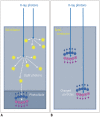Spectral Computed Tomography: Fundamental Principles and Recent Developments
- PMID: 32932564
- PMCID: PMC7772378
- DOI: 10.3348/kjr.2020.0144
Spectral Computed Tomography: Fundamental Principles and Recent Developments
Abstract
CT is a diagnostic tool with many clinical applications. The CT voxel intensity is related to the magnitude of X-ray attenuation, which is not unique to a given material. Substances with different chemical compositions can be represented by similar voxel intensities, making the classification of different tissue types challenging. Compared to the conventional single-energy CT, spectral CT is an emerging technology offering superior material differentiation, which is achieved using the energy dependence of X-ray attenuation in any material. A specific form of spectral CT is dual-energy imaging, in which an additional X-ray attenuation measurement is obtained at a second X-ray energy. Dual-energy CT has been implemented in clinical settings with great success. This paper reviews the theoretical basis and practical implementation of spectral/dual-energy CT.
Keywords: Computed tomography; Dual energy; Spectral; X-rays.
Copyright © 2021 The Korean Society of Radiology.
Figures






References
-
- Flohr TG, McCollough CH, Bruder H, Petersilka M, Gruber K, Süss C, et al. First performance evaluation of a dual-source CT (DSCT) system. Eur Radiol. 2006;16:256–268. - PubMed
-
- Flohr TG. CT systems. Curr Radiol Rep. 2013;1:52–63.
-
- Kyriakou Y, Kalender WA. Intensity distribution and impact of scatter for dual-source CT. Phys Med Biol. 2007;52:6969–6989. - PubMed
-
- Petersilka M, Stierstorfer K, Bruder H, Flohr T. Strategies for scatter correction in dual source CT. Med Phys. 2010;37:5971–5992. - PubMed
Publication types
MeSH terms
LinkOut - more resources
Full Text Sources
Other Literature Sources
Medical

